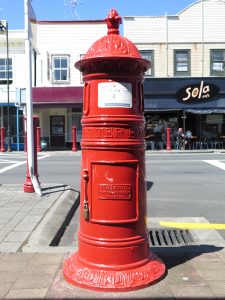
One of Thames’ three Levinge pillar boxes. This one is located on Pollen Street. (Image sourced HNZ Media Release
"Heritage New Zealand has listed Thames’ historic pillar boxes as a Category 2 historic place.
“One of the pillar boxes in Pollen Street, for example, is the oldest in use in the North Island, and the second oldest in the country. People have used it to post letters for almost as long as the township of Thames has been in existence.”
"Two of Thames’ three pillar boxes, which were designed by New South Wales Post Office clerk Thomas Levinge, were installed in 1869, with the third added in 1878.
The Media Release is as follows:
June 9
MEDIA RELEASE
Historic post boxes listed by Heritage New Zealand.
Heritage New Zealand has listed Thames’ historic pillar boxes as a Category 2 historic place.
The listing identifies the nineteenth-century post boxes collectively as a place of historical or cultural significance.
The wider Thames Coromandel area was extensively occupied by Maori up until the emergence of the township and the mining industry in 1867.
“When gold was discovered that year, the township of Thames was established and the area enjoyed prosperity,” says Heritage New Zealand’s Heritage Adviser Registration, Martin Jones.
As Thames celebrates its 150th anniversary as a major urban centre this year, it is interesting to remember that two of these pillar boxes were installed at much the same time that the gold-mining settlement was founded says Martin.
“One of the pillar boxes in Pollen Street, for example, is the oldest in use in the North Island, and the second oldest in the country. People have used it to post letters for almost as long as the township of Thames has been in existence.”
Two of Thames’ three pillar boxes, which were designed by New South Wales Post Office clerk Thomas Levinge, were installed in 1869, with the third added in 1878.
Once the earliest-issue pillar box throughout New Zealand, today only four of these ‘Levinge’ designs remain on the country’s streets – three in Thames, and one in Nelson.
“The Thames pillar boxes are very rare, especially as a surviving group, and their value is also enhanced by what they represent,” says Martin.
“The pillar boxes have been part of the daily fabric of people’s lives for a century and a half because of the importance of their function. Used for posting personal and business letters, they were part of a communications revolution that allowed ordinary people to keep in much greater contact with others in and beyond their community, including overseas.
“That revolution continues today in other forms of technology such as mobile phones, email and the internet. The pillar boxes, however, provide a physical link to the historical origins of that social change.”
Levinge-style post boxes were limited to New Zealand’s main centres, and their presence in Thames reflected the settlement’s dramatic emergence as an important economic force, growing to become the country’s fifth largest centre within a couple of years of its beginnings as a mining town.
“The pillar boxes showed that Thames and its gold-based economy had ‘arrived’,” says Martin.
Although the boxes have been shifted within the town to accommodate changing community needs and priorities – a process started in the 1880s – that only serves to highlight their importance and versatility according to Martin.
“They still enjoy high public esteem, and have done for many years. When the Post Office began replacing the Levinge post boxes around the country with the standard wooden hutch-type boxes mounted on posts in the 1960s, the people of Thames fought back and the pillar boxes were retained. Today they are exceptionally rare survivors.”
Read the Listing report in full here:












Comments are closed.